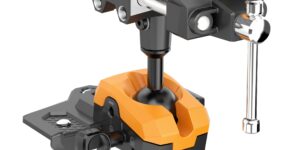The Long and Winding Road
Mike Riley reports how the recent DoD agreement between Lockheed Martin and Sciaty points to EBDM as a promising new technology that could potentially change the world of machining high-value parts.
Posted: May 9, 2012
In conventional forging, once the part is designed, tooling and dies are typically designed and fabricated prior to the initial part being produced. But EBDM uses flexible tooling that virtually eliminates the time spent designing and manufacturing custom tools and dies. Due to the long lead times associated with producing custom forging dies, engineers must typically have the complete part design finished prior to committing to the cost of fabrication tooling. But EBDM allows initial designs to be more aggressive because changing or adding features in a subsequent design typically has minimal impact on the secondary EBDM build cycles.
In EBDM a fully-articulated, moving electron beam gun melts metallic wire feedstock. The highly efficient electron beam power source can be precisely focused and deflected using electromagnetic coils at rates well into thousands of hertz. Typical electron beam welding systems generate operate under 30 kW or 42 kW of power. The high energy density of the electron beam can process very difficult and expensive materials like tantalum and tungsten. The metallic wire is used with electron beam inside a high vacuum environment to provide a contamination-free work zone that does not have to use additional inert gases commonly used with laser and arc-based processes.
In EBDM, feedstock material is fed into a molten pool created by the electron beam. A CNC moves the molten pool about on the substrate plate and adds material only where it is needed to produce the near net shape. This process is repeated in a layer-by-layer fashion, until the desired 3D shape is produced. Depending on the part being manufactured, deposition rates can range up to 250 cu in per hour. With a light alloy, such as titanium, this translates to a real-time deposition rate ranging from 15 lb up to 40 lb per hour. A wide range of stainless steels, cobalt alloys, nickel alloys, copper nickel alloys, Tantalum and many other high-value engineering alloys are compatible with EBDM and are readily available in the form of welding wire from an existing supply base.
This could definitely change the game in the aerospace industry, where the “buy-to-fly” ratio is routinely used to describe the cost associated with the amount of raw materials required to produce a finished part. With ever-increasing performance requirements being requested of modern aircraft, designers are using more titanium, nickel and other high performance alloys to meet performance demands.
Although these super alloys perform well in the final application, that performance comes at a high cost. The raw materials are both expensive and difficult to fabricate using conventional operations, such as forging and machining. But because EBDM deposits material only where it is needed, it not only reduces the amount of starting materials required, it also slashes the machining time needed in secondary operations by up to 80 percent.
Let’s think all of this through again for a moment: EBDM targets the most expensive materials to process on the planet for the most demanding critical applications known to man and, in every case, could potentially cut the purchased price of the typical material lot sizes by orders of magnitude. That’s not all. Lead times will be radically shortened as manufacturing and overhead costs are drastically reduced because only a fraction of the tooling, machining and secondary operations are required that are typically needed on, say, custom forgings. No more headaches waiting for dies, molds, expensive billets, etc. Game changing.
These significant reductions in costs and delivery times to manufacture critical components of the highest value for customers make the total cost of ownership of a new EBDM cell much more feasible and attractive. Next month we’ll continue down the long and winding road with a look at how EBDM could radically change the world for defense suppliers and open new markets for Sciaky.










